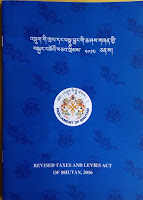 With
the approval of increase in the slab for PIT by the National Assembly of Bhutan
from initial amount of Nu.100,000 as basis exemption, it has now revised to
Nu.200,000 with effect from 7th July 2016 as reported in Revised
Taxes and Levies Act of Bhutan, 2016
With
the approval of increase in the slab for PIT by the National Assembly of Bhutan
from initial amount of Nu.100,000 as basis exemption, it has now revised to
Nu.200,000 with effect from 7th July 2016 as reported in Revised
Taxes and Levies Act of Bhutan, 2016 The
increase in the slab rate came as the much awaited decision from the National
Assembly of Bhutan giving an opportunity save an extra amount. The increase in
the slab rates comes with both advantage and disadvantage to the country. Around
46,105 taxpayers will be benefiting from the tax exemption, however it will cost
the country to lose up to 484 million of ngultrum as forgone revenue
The
increase in the slab rate came as the much awaited decision from the National
Assembly of Bhutan giving an opportunity save an extra amount. The increase in
the slab rates comes with both advantage and disadvantage to the country. Around
46,105 taxpayers will be benefiting from the tax exemption, however it will cost
the country to lose up to 484 million of ngultrum as forgone revenue
With
the increase in the slab rate, an individual will not file their personal
income tax return if their annual earnings do not exceed Nu.200,000. On the
other end, the tax rate will remain same as it is now. Income with Nu.200,000
to will 250,000 will have 10% as tax rate, 15% for Nu.250,001 to Nu.500,000,
20% for Nu.500,001 to 10,00,000 and 25% for Nu.10,00,000 and above. It is also
informed by the Prime Minister that the increase in the slab rate comes after 15
years of its implementation and it would mean a lot to the lower income
brackets. Bhutan’s current slab rate is also the lowest income tax slab in the
region as reported by the Finance Minister.
The
purpose of increase in the slab rate was also to cope up with the current
inflation rate of Bhutan which stands at 3.31 % in the second quarter of 2016
as reported in the trading economics (2016) . There is also an
increase in the amount of education allowance expenses from Nu.50,000 to
Nu.150,000 beside the increase in PIT Slab giving lesser final tax liability for
the tax payers. Beside the financial benefits the taxpayers would enjoy, it
would also reduce the work load for the tax officials while carrying out both
self and desk assessment. The decrease in the work load will have positive
influence with increase efficiency in their service delivery.
References:
Dolkar, D. (2016, June 9). Business Bhutan. Retrieved
from www.businessbhutan.bt:
https://businessbhutan.bt/pit-revision-to-cost-government-nu-484mn-a-year/
National Assembly of Bhutan. (2016). Revised Taxes and
Levies Act of Bhutan. Thimphu: National Assembly of Bhutan.
No comments:
Post a Comment